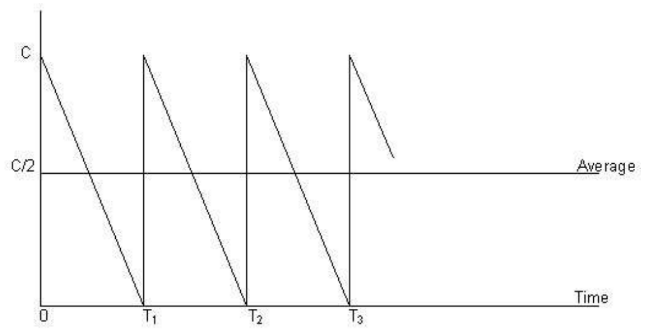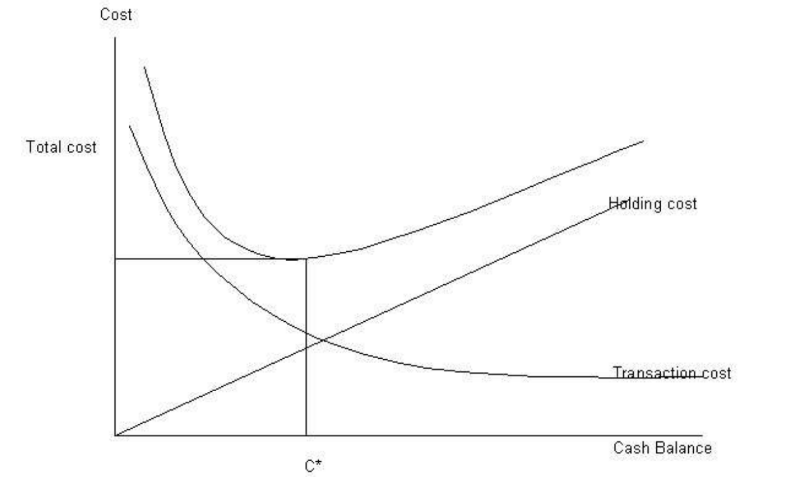Most firms try to minimize the sum of the cost of holding cash and the cost of converting
marketable securities to cash.
Baumol's cash management model helps in determining a firm's optimum cash balance
under certainty. As per the model, cash and inventory management problems are one and
the same.
William Baumol provided a formal model of cash management incorporating opportunity
costs and trading costs. The Baumol's cash management model is an optimum cash balance
model under certainty. His model can be used in order to establish the target cash balance.
Cash management is considered as similar to an inventory management problem. The firm
tries to minimize the sum of the cost of holding cash and the cost of converting marketable
securities to cash.
There are certain assumptions that are made in the model. They are as follows:1. The firm is able to forecast its cash requirements with certainty that it will
receive a specific amount at regular intervals.
2. The firm's cash payments occur uniformly over a period of time i.e. a steady rate of
cash outflows.
3. The opportunity cost of holding cash is known and does not change over time. Cash
holdings incur an opportunity cost in the form of opportunity foregone.
4. The firm will incur the same transaction cost whenever it converts securities to
cash. Each transaction incurs a fixed and variable cost.
For example, let us assume that the firm sells securities and starts with a cash balance of C shillings. When the firm spends cash, its cash balance starts decreasing and reaches zero.
The firm again gets back its money by selling marketable securities.
For example, let us assume that the firm sells securities and starts with a cash balance of C shillings. When the firm spends cash, its cash balance starts decreasing and reaches zero.
The firm again gets back its money by selling marketable securities. As the cash balance
decreases gradually, the average cash balance will be: C/2. This can be shown in following
figure:

The firm incurs a cost known as holding cost for maintaining the cash balance. It is known
as opportunity cost, the return inevitable on the marketable securities. If the opportunity
cost is k, then the firm's holding cost for maintaining an average cash balance is as follows:
Holding cost = k (C/2)
Where C is the optimal cash balance
K is the opportunity cost
Whenever the firm converts its marketable securities to cash, it incurs a cost known as
transaction cost. Total number of transactions in a particular year will be total funds
required (T), divided by the cash balance (C) i.e. T/C. The assumption here is that the cost per transaction is constant. If the cost per transaction is c, then the total transaction cost will be:
Transaction cost = c (T/C)
Where:
c is the cost per transaction
C is the optimal cash balance
T is the total cash needed during the year
The total annual cost of the demand for cash will be:
Total cost = k (C/2) + c (T/C)
K is the opportunity cost of holding cash balance
Optimum level of cash balance
As the demand for cash, 'C' increases, the holding cost will also increase and the
transaction cost will reduce because of a decline in the number of transactions. Hence, it
can be said that there is a relationship between the holding cost and the transaction cost.
The optimum cash balance, C* is obtained when the total cost is minimum.
Optimum cash balance (C*) = Ö2cT/k
Where, C* is the optimum cash balance. T
is the total cash needed during the year. k is the
opportunity cost of holding cash balances.
With the increase in the cost per transaction and total funds required, the optimum cash
balance will increase. However, with an increase in the opportunity cost, it will decrease.

Limitations of the Baumol model:
1. It does not allow cash flows to fluctuate.
2. Overdraft is not considered.
3. There are no uncertainties in the pattern of future cash flows.
a. The firm is able to forecast its cash need with certainty.
b. The firm's cash payments occur uniformly over a period of time
c. The opportunity cost of holding cash is known and does not vary with time.
d. The firm will incur the same transaction whenever it converts securities to cash.
The optimal cash balance is obtained when the total cost is minimum. The formula for the
cash balance is as follows:
C*=v(2cT)/k
Where:
C* is the optimum cash balance
C is the cost per transaction
T is the total cash needed during the year
K is the opportunity cost of holding cash balance
The optimum cash balance rises with the increase in per transaction cost and the total
funds required decreases with the opportunity cost.
NatalieR answered the question on
June 17, 2022 at 08:03